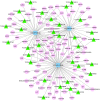Differential expression analysis of mRNAs, lncRNAs, and miRNAs expression profiles and construction of ceRNA networks in PEDV infection
- PMID: 35964002
- PMCID: PMC9375197
- DOI: 10.1186/s12864-022-08805-0
Differential expression analysis of mRNAs, lncRNAs, and miRNAs expression profiles and construction of ceRNA networks in PEDV infection
Abstract
Background: Porcine Epidemic Diarrhea Virus (PEDV) is a coronavirus that seriously affects the swine industry. MicroRNAs and long noncoding RNAs are two relevant non-coding RNAs (ncRNAs) class and play crucial roles in a variety of physiological processes. Increased evidence indicates a complex interaction between mRNA and ncRNA. However, our understanding of the function of ncRNA involved in host-PEDV interaction is limited.
Results: A total of 1,197 mRNA transcripts, 539 lncRNA transcripts, and 208 miRNA transcripts were differentially regulated at 24 h and 48 h post-infection. Gene ontology (GO) and KEGG pathway enrichment analysis showed that DE mRNAs and DE lncRNAs were mainly involved in biosynthesis, innate immunity, and lipid metabolism. Moreover, we constructed a miRNA-mRNA-pathway network using bioinformatics, including 12 DE mRNAs, 120 DE miRNAs, and 11 pathways. Finally, the target genes of DE miRNAs were screened by bioinformatics, and we constructed immune-related lncRNA-miRNA-mRNA ceRNA networks. Then, the selected DE genes were validated by qRT-PCR, which were consistent with the results from RNA-Seq data.
Conclusions: This study provides the comprehensive analysis of the expression profiles of mRNAs, lncRNAs, and miRNAs during PEDV infection. We characterize the ceRNA networks which can provide new insights into the pathogenesis of PEDV.
Keywords: Functional enrichment; PEDV; Signaling pathway; ceRNA network; lncRNA.
© 2022. The Author(s).
Conflict of interest statement
The authors declare that they have no competing interests.
Figures








Similar articles
-
Comprehensive analysis of lncRNA-miRNA-mRNA networks during osteogenic differentiation of bone marrow mesenchymal stem cells.BMC Genomics. 2022 Jun 7;23(1):425. doi: 10.1186/s12864-022-08646-x. BMC Genomics. 2022. PMID: 35672672 Free PMC article.
-
Whole transcriptome analysis of HCT-8 cells infected by Cryptosporidium parvum.Parasit Vectors. 2022 Nov 24;15(1):441. doi: 10.1186/s13071-022-05565-4. Parasit Vectors. 2022. PMID: 36434735 Free PMC article.
-
Analysis of lncRNA-Associated ceRNA Network Reveals Potential lncRNA Biomarkers in Human Colon Adenocarcinoma.Cell Physiol Biochem. 2018;49(5):1778-1791. doi: 10.1159/000493623. Epub 2018 Sep 19. Cell Physiol Biochem. 2018. PMID: 30231249
-
Study on the Relationship between the miRNA-centered ceRNA Regulatory Network and Fatigue.J Mol Neurosci. 2021 Oct;71(10):1967-1974. doi: 10.1007/s12031-021-01845-3. Epub 2021 May 16. J Mol Neurosci. 2021. PMID: 33993410 Free PMC article. Review.
-
The potential regulatory role of the lncRNA-miRNA-mRNA axis in teleost fish.Front Immunol. 2023 Feb 21;14:1065357. doi: 10.3389/fimmu.2023.1065357. eCollection 2023. Front Immunol. 2023. PMID: 36895573 Free PMC article. Review.
Cited by
-
Comparative analysis of the whole transcriptome landscapes of muscle and adipose tissue in Qinchuan beef cattle.BMC Genomics. 2025 Jan 14;26(1):32. doi: 10.1186/s12864-025-11223-7. BMC Genomics. 2025. PMID: 39810084 Free PMC article.
-
Regulatory Non-Coding RNAs during Porcine Viral Infections: Potential Targets for Antiviral Therapy.Viruses. 2024 Jan 13;16(1):118. doi: 10.3390/v16010118. Viruses. 2024. PMID: 38257818 Free PMC article. Review.
-
Exosomal ssc-miR-1343 targets FAM131C to regulate porcine epidemic diarrhea virus infection in pigs.Vet Res. 2024 Jul 22;55(1):91. doi: 10.1186/s13567-024-01345-3. Vet Res. 2024. PMID: 39039559 Free PMC article.
-
PEDV inhibits HNRNPA3 expression by miR-218-5p to enhance cellular lipid accumulation and promote viral replication.mBio. 2024 Feb 14;15(2):e0319723. doi: 10.1128/mbio.03197-23. Epub 2024 Jan 23. mBio. 2024. PMID: 38259103 Free PMC article.
-
The long non-coding RNA lncRNA-DRNR enhances infectious bronchitis virus replication by targeting chicken JMJD6 and modulating interferon-stimulated genes expression via the JAK-STAT signalling pathway.Vet Res. 2024 Nov 5;55(1):141. doi: 10.1186/s13567-024-01396-6. Vet Res. 2024. PMID: 39501382 Free PMC article.
References
MeSH terms
Substances
LinkOut - more resources
Full Text Sources

